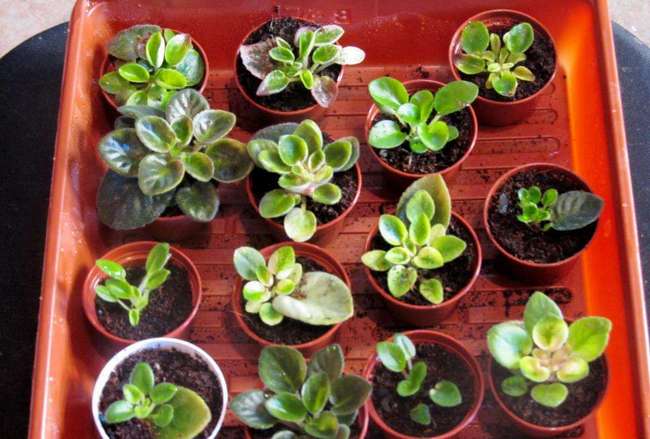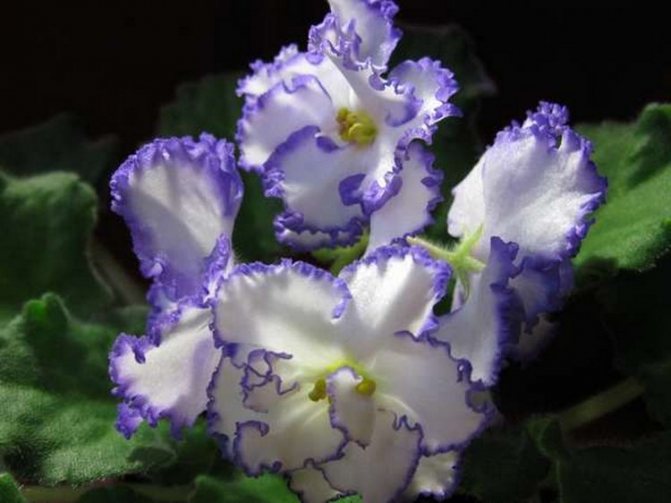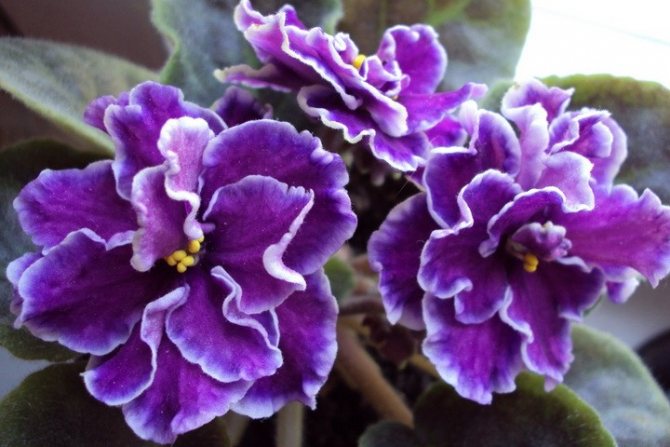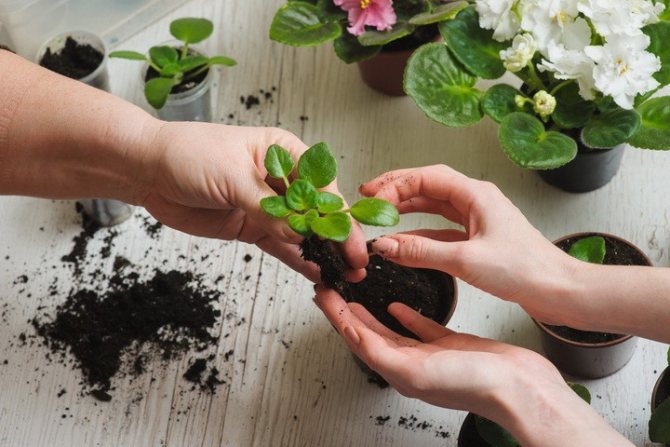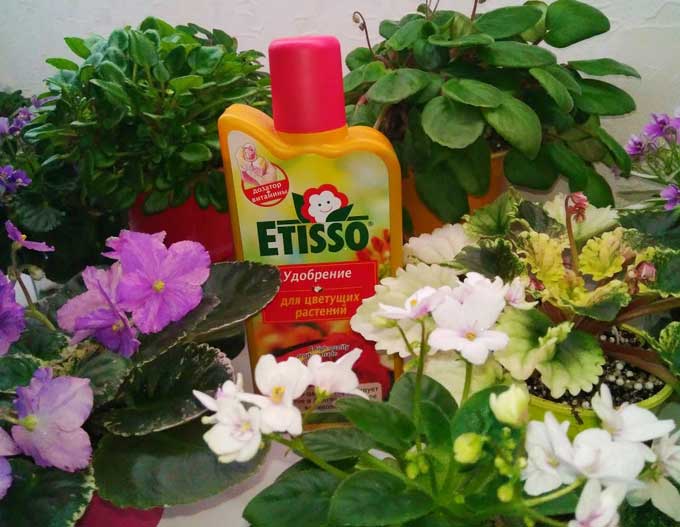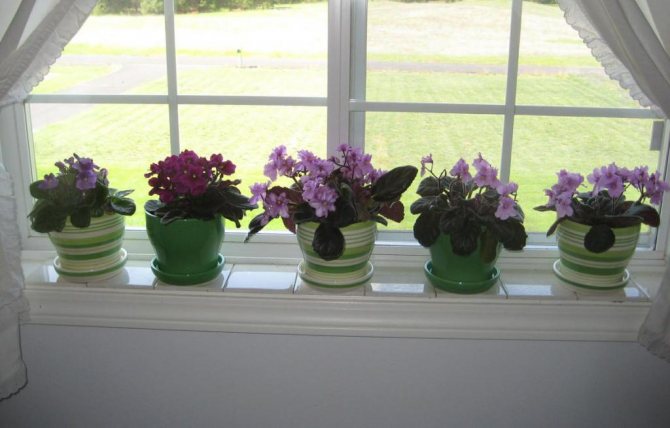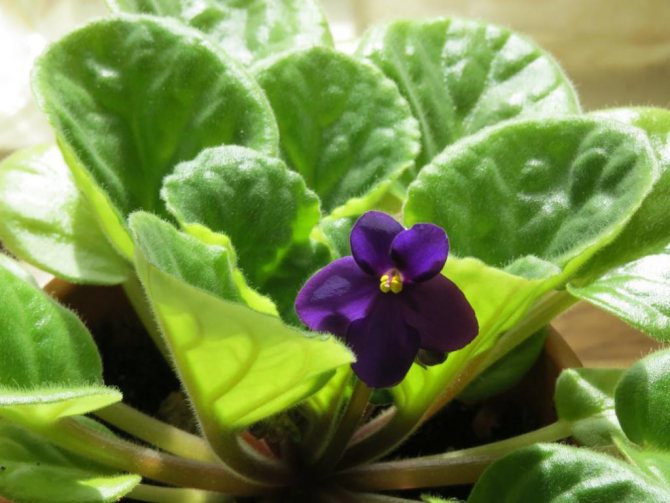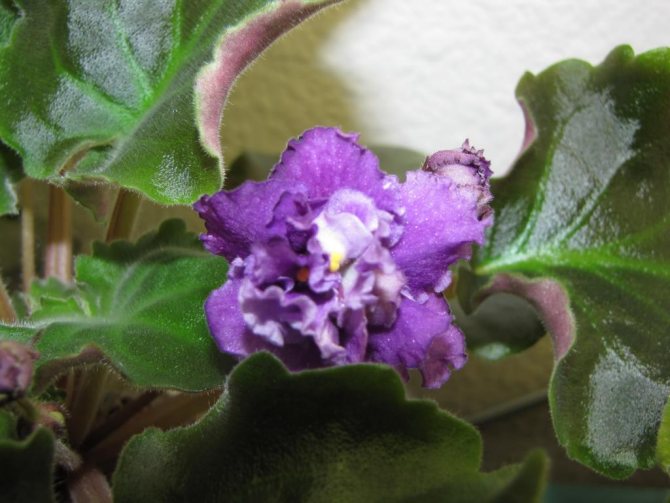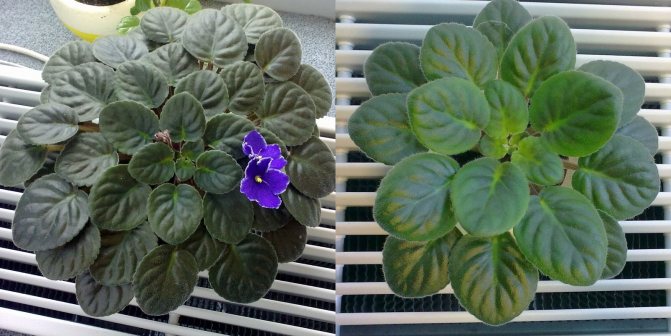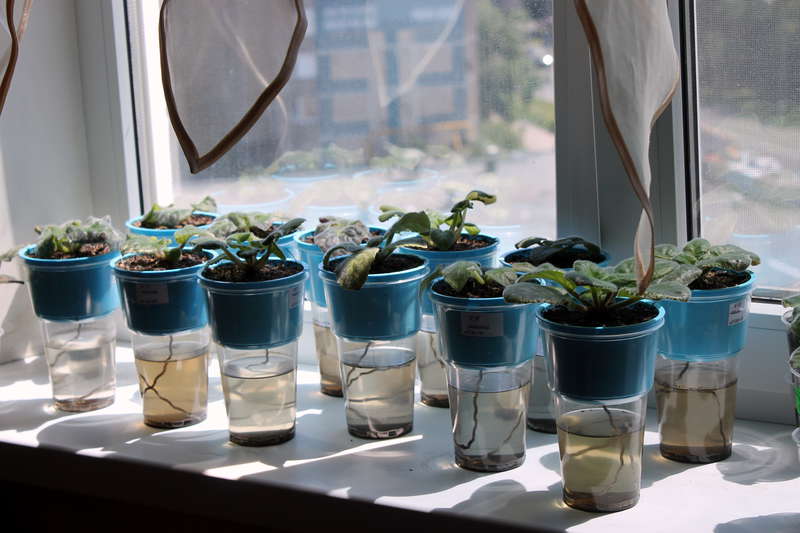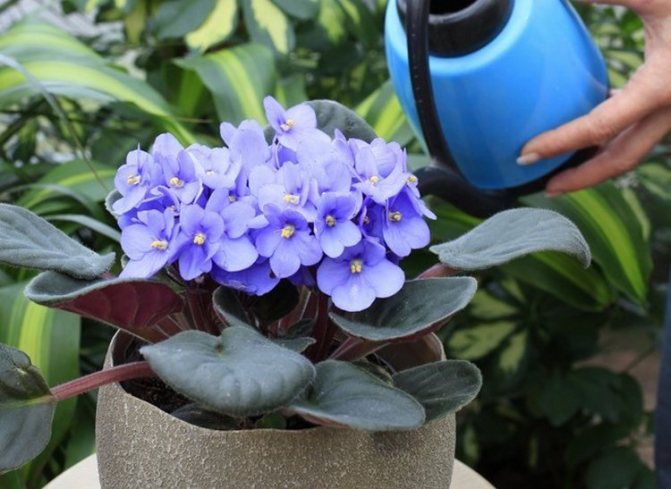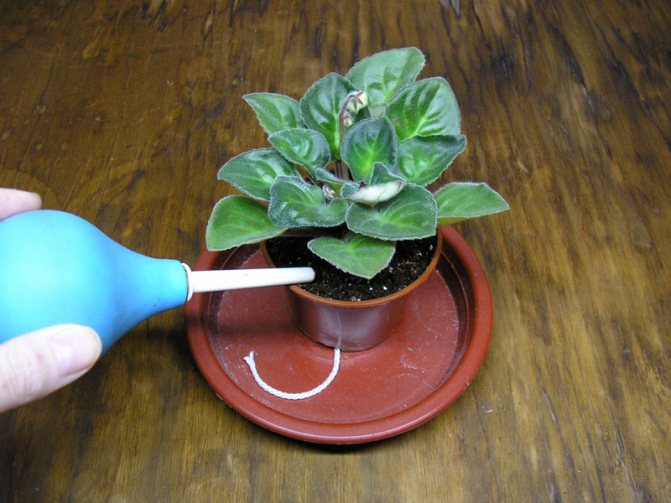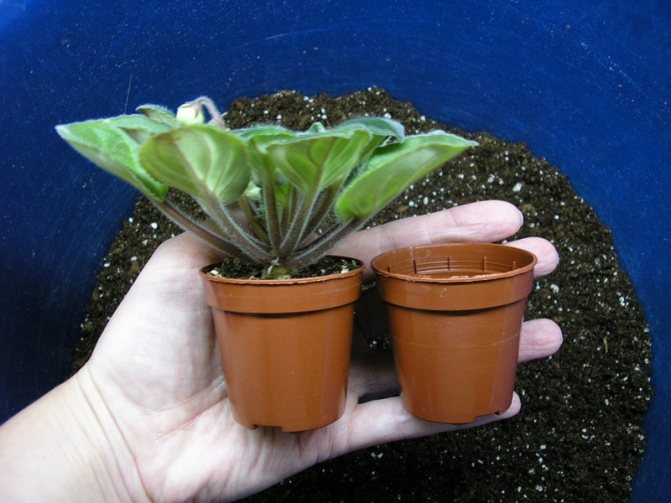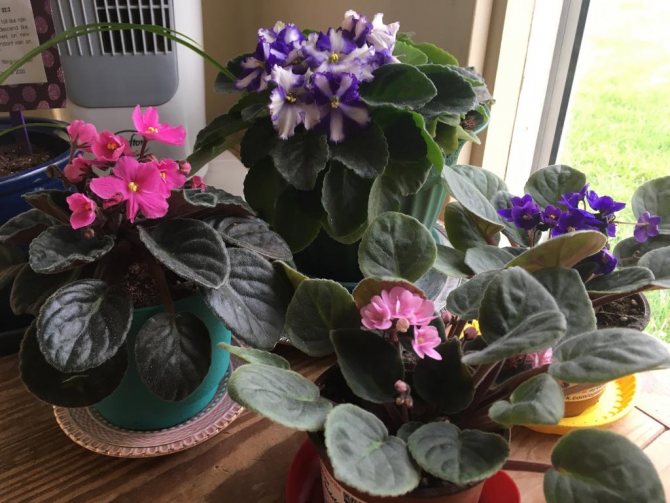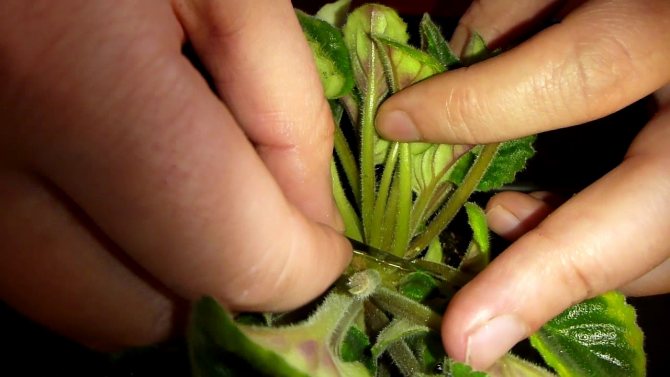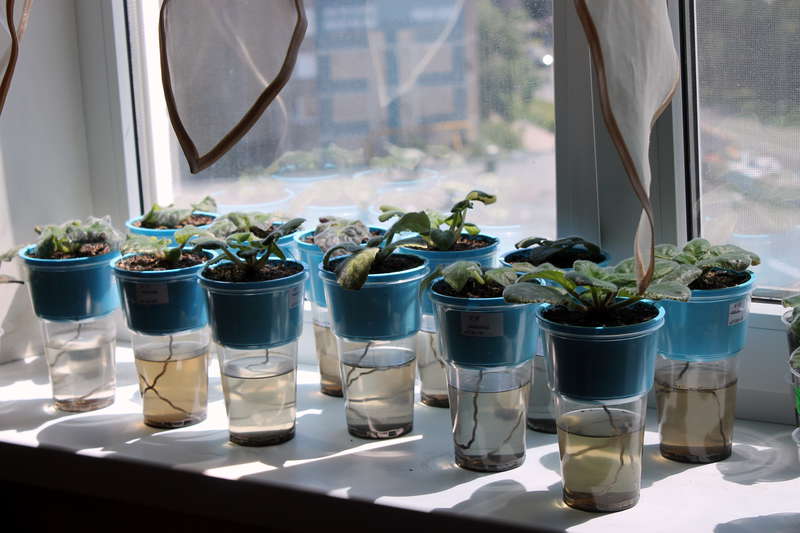Not every indoor plant lover knows why the violet does not bloom. In most cases, this is due to improper care or creating unfavorable conditions for growth. To correct the situation, it is necessary to correctly identify the cause of the problem and find the best solutions.
Growing violets. Illustration for this article is used under a standard license.
Pot size and soil composition
It all starts with a container for a plant. Novice growers mistakenly plant a violet in a hefty pot. They believe that the greater the volume, the more magnificent and abundant the flowering will be. But they just do not know one trick.
The violet begins to bloom only when its roots are almost completely enveloped in an earthen ball. Until this moment, the buds can not be expected. Violet is not up to you, she needs to build up the root system. Therefore, it must be planted in a tiny container.
How to calculate the pot size? It's simple. We measure the approximate diameter of the rosette of leaves and divide by three. The resulting figure will be the diameter of a suitable container. For example, your violet from the tip of one sheet to the tip of the opposite is 16 cm. We make the necessary calculations. It turns out that the pot should be only 5 cm in diameter.
Advice. Do not be afraid that such a volume of soil is too small for a plant. Everything is within the required norm.
By the way, about the soil. Probably dragged from the garden? Moreover, they poured directly on top of the beds. Of course, at the same time they pinned the seeds of weeds, all sorts of nasty bacteria, gluttonous larvae. Well done! What kind of flowers are you? The top layer of soil in the garden is almost always depleted. What is there to eat violet leaves, not to mention the buds.
No, no one demands to run to buy land in the store. It is quite possible to do it yourself. You just need to know some of the nuances. Violets love sour soil. Where is this one? That's right, under the trees or pines. Only it is too dense there. It must be diluted with clean sand and loose peat. It is desirable in the same proportions.
If you are a real fanatic florist, then you probably have vermiculite or perlite in stock. They can also loosen dense soil. Now you can plant a violet. On such wealth, but not to bloom? It is sinful.
And further. You need to transplant a violet every 7-8 months. This is not done to increase the volume of the pot. It's just that during this period the land is usually depleted, salt deposits form on it. The purpose of the transplant is a complete soil replacement.
Advice. Acidify the soil in the violet pot about once a month. This can be done by adding a pinch of citric acid to a liter of water. Or replacing the top 1.5-1.8 cm of soil with a new one.
how to properly water an orchid
Damage to the flower by parasites
To achieve flowering violets, you need to exclude the appearance of parasites and pests on it. Even the smallest insects can seriously harm the plant, completely depriving it of life.
Violets are capable of infecting:
- Worms. If you notice red spots on the leaves of your room pet, these may be the places of bug bites. You can find the culprits themselves in the folds of the leaves, and their larvae (white worms with a fluffy body) can hide in the soil.

- Aphid. You can see these insects with the naked eye - they will attack the buds and flowers of blooming violets.Aphids can be caused by freshly cut flowers that you yourself brought from the street to the house.
- Ticks. On violets, you can see either a red spider mite, which leaves behind red dots, outlined by cobwebs, or cyclamen - it leaves round yellow spots on the leaves of violets.
Lighting and air temperature
So, we sorted out the land. The violet still does not bloom, but only pulls the leaves. And why does she pull them when she has to spread it out with a wide socket? She asks for light, that's what. Another bloom secret is good diffused lighting for at least 13 hours a day. It is especially important to supplement the whim in the evening, in the morning she will have enough sun.
It is necessary to supplement it with special phytolamps. A regular daylight lamp will do just fine.
By the way, there will be enough sunlight on the southern window of the violet. Here are just straight lines are able to burn it completely. Therefore, be sure to shade it with white paper, light blinds or thick tulle. It is important to scatter the sun, not block it out.
About temperature. It must be stable. The greatest number of flower buds of a violet lays at about + 16-17 ° C. As the temperature rises, the number of buds decreases. When lower, the root system stops working. The maximum allowable value is + 24 ° С. Above is already a threshold.
How to lower the air temperature near a violet in the summer at home? Those who have an air conditioner at home have nothing to worry about. Well, other growers will have to tinker. In the summer, you can periodically air violets, especially at night when it is cool. Place plastic ice bottles next to the pots during the day.
In winter, the temperature in some houses is sometimes too high too. But at this time of year, it's easier to get a snowball and put it next to the pots on a plate. You can even cover the radiator under the window with a thick blanket, thick blanket or towel.
By the way, you need to put insulation under the pot. This can be a piece of wood, a cork stand, a foam board, or a piece of foam backing. Then the roots will not freeze, and their work will be stable.
In general, for the most part, it is on stability that the rapid flowering of violets is based. If you perform all the care manipulations strictly on schedule at the same time for a long period, then the violet will get used to regularity. And he will be happy to release the buds.
And if the care is temporary, as they remembered - it was watered or fertilized, there is no time for fat. What flowers, the violet itself would be able to extrude.
how to cut dracaena at home
Violet care: features
Indoor violet prefers the east or north side of the house. If the windows are on the south side, it is recommended to shade the flower with tulle curtains or blinds. It is not recommended to put the flower pot further than 0.5 m from the window. The ideal option is violets on the windowsill.
The optimum night temperature for violets is + 18 ° С, daytime + 22-24 ° С. Florists recommend enjoying the blooming violet in winter. If the violet blooms during the summer heat, it is advisable to remove the peduncles so that the plant can go into a dormant state.
The lower leaves of the violet can be washed gently if they are dusty. However, during the procedure, you must follow a few simple rules.
- Using a gentle pressure of running water, gently rinse the lower leaves with water. Make sure that no water gets into the center of the flower and into the pot.
- Shake the plant a little. Then place the pot in a dark, draft-free place until the leaves are completely dry, for example, on a mezzanine. If this is not done, the leaves will be covered with spots. After a day, the flower can be returned to its permanent place of residence.
To the content
Watering and humidity
These factors are also important for flowering. Proper and timely watering allows the violet to be sure that it can pull all the flowers.If you drink a lady from time to time, then what are you waiting for? Remember stability.
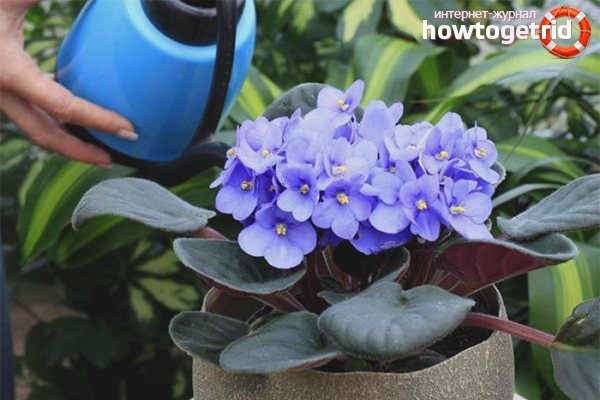

Only you can't water the violet like other flowers - from above or by sprinkling. We need to arrange a wick system. Or gently pour some water around the edge of the pot so that it does not fall on the leaves. But the most convenient way is immersion. We put a pot of violets in a large container, poured lukewarm water. After 15 minutes, they pulled out, allowed the excess to drain and returned to its original place.
Air humidity also matters. What is the point of dissolving the flowers if they will soon wither from dryness anyway? Let the violet think that the amount of water in the room's microclimate is okay. This is very easy to do. There is great scope for imagination, you just have to choose:
- Additional containers of water are placed next to the flowers.
- Periodically spray the air around the violets from a spray bottle.
- Wet expanded clay or peat is laid out on a wide pallet.
- In winter, cover the radiators with a damp towel and moisten it as it dries.
- On a saucer next to put snow or ice.
All methods are quite workable at home. And the benefits are enormous. The main thing is to do it regularly and without long breaks.
how to keep chrysanthemums in a vase longer
In order for the flowering period of the violet to be long, it is necessary to be able to properly care for the plant.
print version
(29 votes) Rate this article
Saintpaulia, or violet, is one of the most popular indoor plants. Among domestic species, there are Saintpaulias with double or semi-double flowers of various colors and sizes. By crossing, breeders have bred more than 500 varieties of violets. Lighting, temperature, humidity, the availability of feeding, the regularity of watering and the timeliness of transplantation play an important role for the normal growth and development of home violets. In order for the flowering period to be long, you need to be able to properly care for the Saintpaulia.
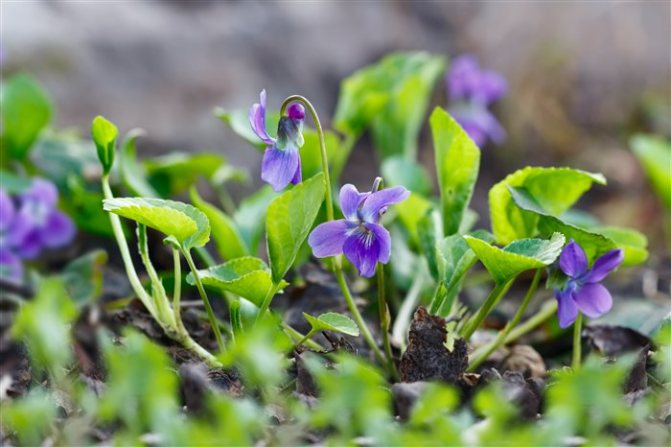

To the content
Fertilizers
In order for a violet to start blooming, it needs the necessary amount of nutrients. If she lacks any mineral elements, then you will not see flowering. Here the leaves would support and the roots, but the owners demand the buds!
Be sure to regularly feed your lady with a full range of mineral fertilizers. In spring, summer and autumn - every 8-9 days. In winter, you can limit your diet a little. But, if it is in the cold season that your violet is going to bloom, then in no case change the regime. Again, the notorious stability.
Advice. If, during the appearance of buds, you change the fertilizer or dosage, then they will simply dry out without having time to bloom.
More on the topic "Care for Saintpaulia: watering violets, transplanting in 2019":
Violets, Saintpaulia. Streptocarpus. Garden plants.
Catalog of varieties of violets, streptocarpus and garden plants. A colorful photo gallery with descriptions, interesting and books, magazines about flowers that you can have Saintpaulia, or a violet - one of the most popular indoor plants. the flowers of the violet fade. Flower care ..
I want to start planting violets, share the leaves who can
Violets. Plant transplantation and breeding .. Floriculture. Houseplant care: planting, watering, feeding, flowers, cacti. I am a beginner florist, I breed them for only two years, last year I planted violets, bought them in a botanical garden, and at best they are from If and ...
The violet bloomed for the first time.
How to properly care for violets. If the violets bloom during the summer heat, it is advisable to remove the peduncles so that the plant goes into a dormant state. The rosette of the flower should be three times the diameter of the pot.
violets
How to properly care for violets. the flowers of the violet fade. Houseplant care: planting, watering, feeding, flowers, cacti. How to properly care for violets. Sluggish leaves of a violet .. Diseases of plants .. Floriculture.
gave a violet ...
In general, it is not recommended to feed violets with an annual transplant. How to properly care for violets. Watering can be done from above, but the water should not get into the middle of the flower - into the center of growth. You shouldn't put a pot of saintpaulia in a draft, from ...
Violet - purchase and transplant ???
Violet - purchase and transplant ??? Please tell me the pros! She bought a violet, as usual, in a plastic pot, and it blooms. Saintpaulia disappears 

Has anyone grown a violet of souls from seeds
How to properly care for violets. You can also grow geraniums from seeds, but I prefer grafting, which is carried out from the middle Section: Flowers (who grew violets from seeds). It is necessary to sow fresh seeds, otherwise nothing will come of it ... I tried it several times, with ...
the flowers of the violet fade
the flowers of the violet fade. Flower care .. Floriculture. pro, tell a beginner, please! in violets, a week after the beginning of flowering, they begin to fade and flowers fade like chintz in the sun. How to properly care for violets. Violet does not bloom.
How to spray violets
How to properly care for violets. You cannot spray a violet with water. Possible causes and methods for eliminating them: - waterlogging of the soil - you can carefully remove the violet from the pot and see if there are any rotten roots.
question about violets
How to properly care for violets. In order for the flowering period of the violet to be long, you need to be able to properly care for the Saintpaulia. 7ya.ru - information project on family issues: pregnancy and childbirth ...
violets
Houseplant care: planting, watering, feeding, flowers, cacti. I am a beginner florist, I breed them for only two years, last year I planted violets, bought them in a botanical garden, and at best they grew up with me, but they don't bloom, although the bushes are already quite fluffy, but in ...
The violets have turned pale!
The violets have turned pale! Hello everyone! Tell me, please, I bought a violet, it was bright pink, it continues to bloom, but the flowers are paler than they were before. I read somewhere that alkaline soil may be the cause. What is your opinion? If so, how do you fix the situation?
About transplanting violets.
Houseplant care: planting, watering, feeding, flowers, cacti. Section: Plant transplantation and breeding. (I bought in the House of Violets several not yet flowering plants, violets, in the sense, after what time is it better to transplant them into pots?)
violets
violets. Flower care .. Floriculture. Section: Flower care. (Hello! I looked to you from the children's conference for advice). All my pots are made of plastic, with drainage at the bottom, without moss, one violet lived for 2 years in its own pot (in which it was sold), wilted ...
Help with the violet!
Help with violet!. Plant transplantation and breeding .. Floriculture. Houseplant care: planting, watering, feeding, flowers, cacti. Please advise what to do with the presented miniature Dutch violet. I'm afraid of violets - I tried to grow them ...
Why does not the violet bloom.
Why does not the violet bloom .. Caring for flowers .. How to properly care for violets. To the content. Reproduction of violets by cuttings and stepsons. Cuttings can be cut from a middle-aged plant.
If the ground is moldy
I have violets, it's easier for me to transplant. And if you fight, then first of all water with filtered, acidified water (add a little Houseplant care: planting, watering, feeding, flowers, cacti, if the fertilizer smells like ammonia.
The limp leaves of the violet.
Sluggish leaves of a violet .. Diseases of plants .. Floriculture. Houseplant care: planting, watering, feeding, flowers, cacti. The limp leaves of the violet. Girls, how can I help them? The most beautiful violet in the house blooms, whose leaves were no worse in beauty than ...
Is the violet sick?
Tell us about violets. Explain what “varietal saintpaulia” means? I’ll ask about violets too. They used to bloom, the leaves were elastic, but now they seem to be wilted, soft leaves, the care has not changed after them. What is it, it's time to rejuvenate?
Pests and diseases
Well, what flowers do you dream of if your violet is sick? Or suddenly nasty insects overwhelm her? Eliminate these annoying factors first. And do not provoke the emergence of new ones.


For example, too low air or water temperature for irrigation is a direct factor in the appearance of rot. Or the appearance of a fungus on a plant. Do you think this is where it comes from? From illiterate care. A healthy, full of strength violets have a strong enough defense system. If the capricious is cheerful and cheerful, then no spores and bacteria are afraid of her.
Than to cure the violet later, it is better to help it with prevention. Add phytosporin or em-preparations to the water for irrigation and planting soil.
Where do the pests come from? With other flowers in the house. They arrive from the street. Crawl out of non-disinfected soil. Or in the warm season they took out to breathe a violet in the garden, on the balcony, on the loggia. Think everything will be okay? It won't do. Some rubbish will not fail to take advantage of the hospitality of your sleek and polished beauty. It will certainly settle on the underside of the leaves or at the roots.
And it will be difficult to withdraw them. After all, it is not so easy to wet the fluff on the leaves. And where to wait for flowers, when insects drink all the nutritious juices?
Advice. Be sure to periodically inspect violets for diseases or pests. Get rid of uninvited guests in a timely manner.
how to transplant a cactus at home
Violet diseases
With improper care of violets, the likelihood of various diseases developing in a flower also increases. Therefore, if the plant is not blooming, inspect it for signs:
- Fusarium. This disease is provoked by a fungus that develops in moist and dense soil and begins to infect the roots of the plant. The main sign of fusarium is the absence of flowering, grayness and leaf fall.
- Powdery mildew. With a lack of light, cold and high dustiness of the room, the leaves of violets can become covered with a white spiderweb bloom, which indicates the development of powdery mildew.
- Gray rot. A gray-brown coating that resembles fluff is a symptom of gray rot. To make sure that there is a disease, just remove the plaque from the leaf - if there is a rotten area under it, then the first diagnosis was accurate. Gray rot appears with temperature extremes or excessive watering.
Extreme methods
Sometimes the owners dance around the violet anyway, and lick it this way, courting it. And she, such a lady, still does not indulge in flowers. Some sources recommend giving the plant a little shake. Such a shock.
To do this, leave the upper 6-7 leaves in the outlet, the rest of the lower ones cut off everything. The wounds are dried for 2 hours. Then the violet is transplanted into new soil, but they are placed not in heavenly conditions, but in a dark, cool place. For example, in the closet or under the kitchen sink. For about 28 days.
During this time, the lady is watered once so that she does not get stuck at all. Then they are taken out into the light and returned to their usual habitat, with all the ideal conditions. If after a month the violet does not begin to bloom, then the procedure is repeated.
Again, breaking off the leaves and further down the list. According to reviews, sometimes one such shock is enough, so that then the violet blooms continuously for up to six months.
The method is cruel, but very effective. Only after flowering, do not repeat it again. Give the violet a break.
Advice. When repeating the procedure, do not jerk the root system too much. Try to keep as many small feeding roots as possible. Otherwise, instead of buds, the violet will spend all its strength on recovery.
How to make a violet bloom at home? No way. To butter up - you can.If, after all the ideal conditions and competent care, the capricious woman still refuses to bloom, then do not rack your brains and do not shake your nerves. Grow other flowers. Violets don't like you.
how to organize watering indoor flowers while on vacation
How to make a violet bloom with a hat
The conditions for the flowering of a violet with a bunch, or, as it is also called, a cap, are, first of all, a varietal property (there are varieties that, even with the largest and most careful attempts of the owner, cannot bloom with a cap), the growth of all peduncles from the very top of the rosette and the same age all peduncles.
It is possible to ensure the growth of peduncles from the top of the outlet by extending daylight hours to the optimal 12 hours. In addition, it is important to maintain the air temperature at about 20 C, monitor the condition of the soil, transplant the plant on time and enrich it with phosphorus fertilizer every two weeks.
If the violet has not bloomed yet, it is important to allow the rosette to grow many leaves, more than one layer, and only then allow the plant to be covered with flowers. For this, all children and peduncles are pinched off. Only after the plant grows, it will have enough leaves, the allocation of peduncles stops, the conditions described above are created, and the plant will bloom with a beautiful cap.
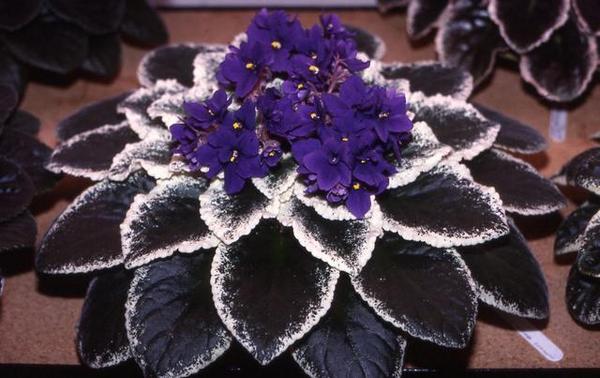

Big pot
Saintpaulia is a small flower and its root system is not extensive. In a large pot, the plant will not be able to fill the entire volume, which is why it will stop developing and blooming, the leaves will turn yellow and dry out. The best option is a small pot, the diameter of which is 3 times smaller than the outlet itself. For an adult violet of medium size, a container with a volume of 200 ml is suitable. For larger flowers, you should purchase larger pots.
The pot material must be suitable so that moisture does not get trapped in the ground, causing root rot. It is recommended to choose a plastic vessel with holes in the bottom.
Pests interfere with the plant


The presence of parasites is also not an incentive to continue flowering.
The main ones are aphids and mites, the vital activity of which is manifested in the formation of a cobweb on the organs of a flower, and worms.
If present, red spots appear on the leaves. In the initial stage, washing with a mild soapy solution helps.
The most dangerous pest for violets is nematodes. These organisms live in the root system and damage it over time, which makes it impossible for the further supply of nutrients to the flower. The violet dies.
To prevent the appearance of nematodes, the substrate in which the violet will grow is recommended to be well calcined in the oven.
Poor quality soil
This is another reason why violets do not bloom. This can be determined by dense soil, on which there is a whitish bloom. When drying, a gap is noticeable between the walls of the container and the ground. Although the plant may look healthy.
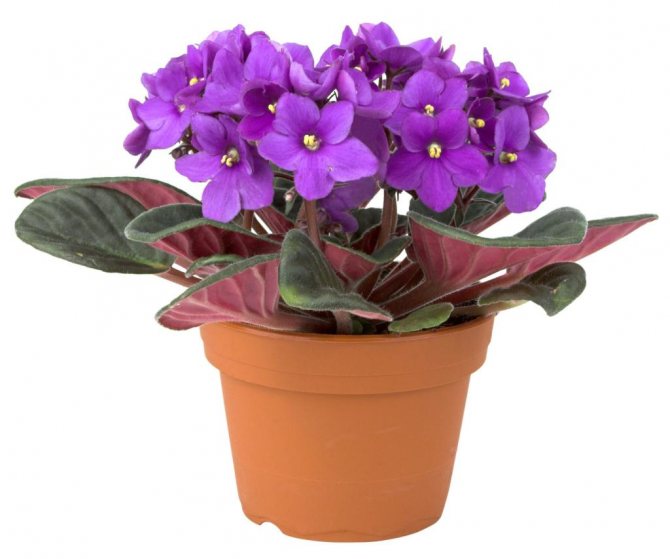

For high-quality and long-term flowering, plants are transplanted 2 times a year. Each time it is necessary to use a new primer. Violets are sensitive to earth depletion, and given the size of the container, this happens quickly. Even regular feeding is not able to save the situation. Food will be poorly absorbed if the soil is dense. It is important that it is loose, fresh and breathable.
Preventive measures
To prevent the violets from wilting, it is necessary to carry out preventive measures:
- Keep the violet clean.
- In the autumn, treat the plant with "Fundazol" to prevent the appearance of fungal diseases.
- Wipe the violet leaves with a damp sponge before processing.
- Do not ventilate the area after spraying or watering the flower.
- Do not water the violet for several days after transplanting to help heal the root wounds.
- Avoid excess nitrogen in the fertilizer.


Recommendations
Violets bloom well at a young age - up to 4 years. Buds on an older plant are rare.The collection must be updated periodically, otherwise the flowers will have to wait for a long time.


Don't let the leaves grow. It is important to keep track of their number per stem. Typically, no more than 7 pieces are required. When there are more leaf plates, there will be no flowers. All efforts will be spent on ensuring the vital activity of the green mass and the development of the root system. You should not allow such an oversight, you always need to remove excess burlocks. Only you should not cut them, but break them.
There are recommendations on how to bring violets to bloom. You just need to water it according to the usual schedule and in a convenient way, but with hot water. But you cannot use boiling water either. The temperature should be between +50 and +52 degrees. According to reviews, plants like this procedure, and flowers form quickly.
Why violets don't bloom or bloom poorly at home
There may be several reasons why violets do not bloom. You need to know them and check the lighting, air humidity, soil and fertilizer quality, as well as adjust the amount of watering and eliminate pests. Let's describe in more detail what is the secret of successful flower care.
Low lighting
As one of the most common reasons for the lack of flowering, the level of illumination is due to the territorial location of the pot with the plant. So, it must be installed where it will be able to be at least 12 hours a day under continuous lighting. In this case, direct sunlight should be avoided.
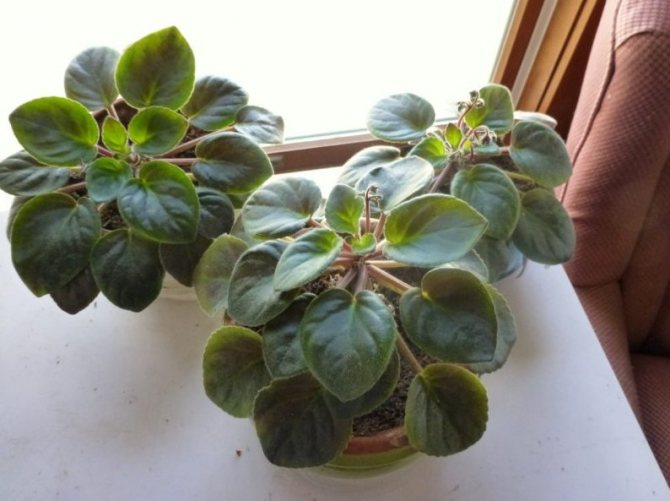

In the summer, you should place the violet on the windowsill, which is on the north side of your home. The northwestern and northeastern parts will also be acceptable. If for some reason you cannot provide the flower with access to natural lighting, then it is recommended to resort to installing artificial. In winter, it is better to place the violet in the southern or western part of the apartment.
Low air humidity
Since the violet is a tropical plant, its maintenance in room conditions should provide for an increased level of humidity, reaching 60-70%. The arid climate negatively affects both flowering and the general condition of the plant. It depletes the leaves, causing them to curl and dry out. To increase the humidity, it is recommended to use a humidifier or simply place containers of water next to the pot.
Important! The most comfortable air temperature for violets will be + 16 ... + 21 ° С.
In addition, there are several other ways to increase the moisture percentage. The most common is the method of placing a pot with a violet in a tray or baking sheet with expanded clay or sphagnum. At the same time, the container should be filled with water by 2/3. You can also increase the required indicator by spraying a flower or washing its leaves with warm water once a month. However, it should be understood that excessive humidity and lack of fresh air can provoke the appearance of fungal diseases.
Incorrectly selected pot
In order for violets to feel comfortable and there are no problems with their flowering, it is necessary to choose the right container for them. So, it should be borne in mind that during growth, their roots tend upward. This is due to the fact that there is more air on the surface, which is so necessary for flowers. It is advisable to choose a violet pot based on data on its size and age. So, for growing young growth, a small container with a height of 5 cm and a diameter of 5 cm is suitable.


At the next transplant, when the plant grows up, the size of the new pot should be 2 cm larger.When the violet reaches its maximum size, it is transplanted into a container, the diameter and depth of which should be 9 cm each, respectively. In addition to the size of the container, it is also important what material it is made of.So, a plastic pot, although it is considered the most durable, lightweight and flexible, but its texture prevents air from entering.
This problem can be leveled using a special pallet or by making holes in the container. The ceramic pot has a drawback associated with the movement of air. In addition, although it can be purchased at a lower price than plastic, it is quite heavy and loses its appearance over time. But keeping a violet in such a container is quite acceptable.
Important! Remember, an incorrectly selected large pot can cause souring of the root system, as well as prevent the onset of flowering, delaying it for at least 2 years.
Poor quality soil
One of the most important factors causing violets to stop blooming is the quality of the soil. So, the substrate used should consist of perlite, sphagnum moss and charcoal. Perlite is a gray or white baking powder that replaces sand if necessary. For violets, this silica should have a granular, not powdery fraction.
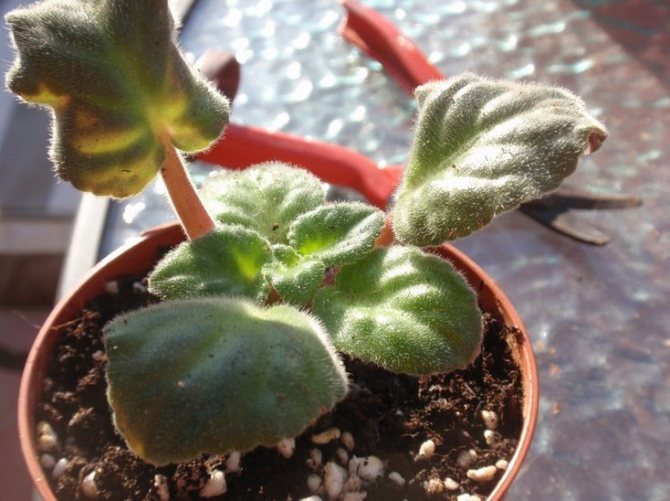

The most suitable will be a soil mixture that includes 4 parts of leafy land and 1 part each of sand and peat. It is also advisable to use coniferous soil. You can make a litter from it and place it at the bottom of the pot. This soil has an acidity of 4–5 pH. In leafy soil, this indicator is slightly higher and reaches 5–6 pH. You can also use compost and vermicompost.
Did you know? According to folklore, when the violet fades, it is necessary to calculate the number of flowers remaining. If the result is an even number, then this promises a profit, and if it is an odd number, losses.
Improper watering and fertilization
Important factors are watering and feeding the plant. The violet needs to be watered, avoiding waterlogging of the soil. In addition, it will be inappropriate to dry out the soil in a pot and use cold, not settled water for watering it. There are several methods for watering a plant.
Let's consider them in more detail:
- Watering from above. During the procedure, it is necessary to pour water from above so that it does not fall on the leaves. The presence of drops in the pallet indicates that the plant is saturated with moisture. After that, you can stop water procedures and pour out the liquid from the pan.
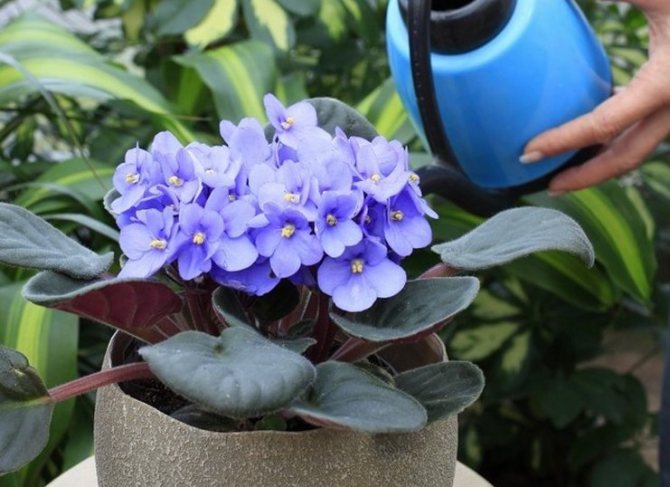

- Watering through the pallet. Water is poured into a saucer under the pot, and after the plant has absorbed the required amount of liquid, the leftovers are poured out.


- Settled water is poured into a wide basin and a pot with a violet is lowered into it for several minutes, after which it is moved to its usual place.
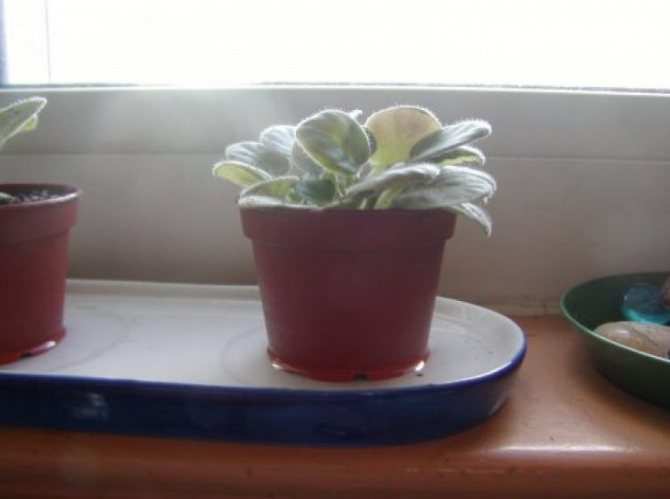

- Wick watering. This method is relevant for those gardeners who care not for a single plant, but for a greenhouse, for example. It is the most energy-consuming and requires the installation of special drainage and equipment, and its essence lies in the fact that the plant independently regulates the amount of liquid consumed. This can be achieved with a thin cord that is placed in a circle between the drainage and soil layers. The other end should be left in a container filled with water, which is placed under the pot.
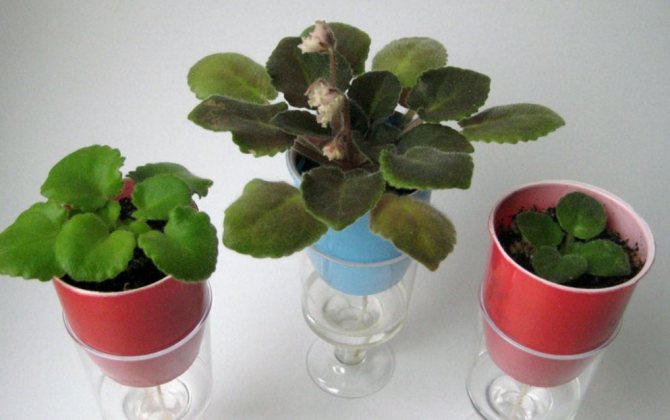

Fertilizers are best purchased from a florist or other store. There are many fertilizers designed specifically for this flower, we will describe the effect of some of them. To strengthen the peduncles, you can use "Brexil Calcium". It must be diluted in 1 liter of water, adding 0.5–1.5 g. Then it is necessary to mix the ingredients and spray the plant with them. This procedure is done before flowering for 1.5-2 months. Repeat it after 2 weeks.
It is recommended to feed the plant weekly. But in this case, it is extremely important not to overdo it with nitrogen in the fertilizer, since its action is aimed solely at crown formation, and not flowering. You run the risk of getting a lot of leaves in the absence of flowers.
Important! In winter, you should not leave the violet on a cold windowsill, because this will provoke hypothermia and death of the roots.
Diseases or pests
The appearance of pests and diseases is hard not to notice for an attentive gardener, it is only necessary to take timely measures to eliminate them.
Let's present a list of the most common diseases:
- Powdery mildew. White bloom begins to spread to the stems and leaves due to the poor climatic conditions in which the flower is located. Low temperature and lack of lighting are the reasons for the appearance of such a disease. You can eliminate this trouble with the help of "Fundazol" and "Benlata". In addition, preventive measures should be taken by wiping the parts of the plant prone to damage with a damp sponge and airing the room.


- Fusarium - a fungus that originates on the roots of a plant from an excess of moisture. Its appearance can also provoke cold watering. In addition to the fact that the violet stops flowering, it begins to shed its leaves.


- Gray rot. It is a gray-brown plaque that covers the leaves and flowers of the plant. May be the result of temperature changes and excess moisture. It is recommended to cut off the affected parts and treat the violet with fugicides. If it cannot be saved, then the flower should be disposed of along with the earth.


Among the most common pests are:
- Scratch. He bites the leaves of the plant, which is why they are covered with small spots of red color. Females of the worm do not live on the surface, but in the soil of the pot. If you treat a violet with "Fitoverm" or "Aktellik" and transplant it, while cleaning the roots and processing from a spray bottle with "Aktara", then it will continue to grow. Otherwise, the flower will die.
- Mite. The consequences of the presence of this pest can be dried leaves of the plant. In addition, depending on the type of mite, spots of a characteristic color may appear on the leaves: red, yellow, and others. This problem can be eliminated with the help of drugs such as Actellik or Akarin.
- Aphid. Feeding on the sap of the plant, it violates the integrity of the buds and flowers, and also affects the buds. To get rid of it, use Actellic or Mospilan.
Did you know? Violets were first found in a mountain range called Usambara, located in East Africa. Today, their largest manufacturer is considered.
Influence of transplant
Exists several transplant factors, which could be violated by the florist, and as a result - the lack of flowering:
- improperly selected soil - choose only marked for violets / saintpaulia. Or if this is not on sale, take it for flowering plants;
- if the soil is taken from the garden, it must be disinfected and high moor peat added to it;
- the container where the flower is planted should not exceed 9 cm in diameter.
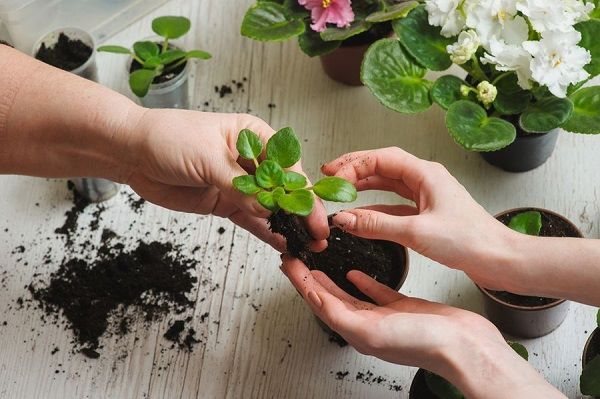

Lack of flowering may be due to improper transplantation.
If these conditions are met, then the first buds can be seen after a month.
Reasons for the lack of flowering
In the absence of flowering, several reasons may be to blame. You can find the one you need and eliminate it only by the method of elimination.
Lack of a dormant period
Violets without fail need a dormant period between floweringwhich can last for several months. During this period, it is not necessary to stimulate flowering, so as not to harm the flowers.
Diseases and pests
Violets can sometimes hurt and be attacked by pests (aphids, thrips, slugs).
When the plant is waterlogged, it is not transplanted for a long time, it is too fertilized, soil insects can grow in the substrate.
If you do not pay attention to them, they will begin to actively multiply and gradually damage the plant, and you can forget about flowering until the plant recovers.
ATTENTION! Eliminating one mistake in care, without eliminating the rest, will not lead to the beginning of flowering.
Common mistakes novice florists make
A beginner lover of violets should pay special attention to conditions in which mistakes are often made when caring for a plant:
- choosing a pot that is not the right size;
- improper feeding - overfeeding or vice versa lack of nutrients;
- choosing the wrong substrate;
- improper watering - water gets on the leaves;
- excessive or insufficient watering;
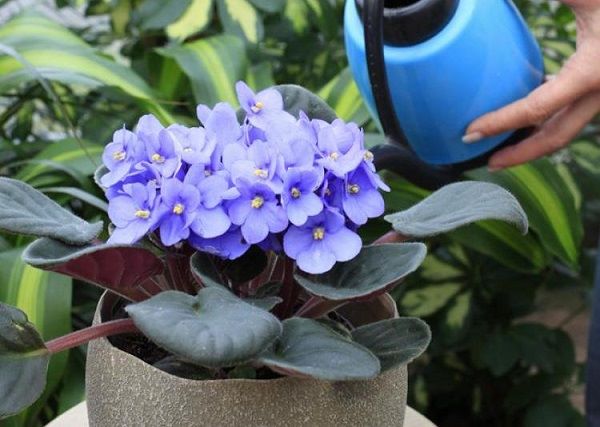

Often, improper watering is to blame for the lack of flowering.
- ignoring the correct conditions of detention - the appropriate temperature and humidity level is not maintained, drafts are allowed;
- finding the plant in direct sunlight;
- untimely transplant;
- there is no periodic inspection of the land for the presence of pests;
- side sockets are not removed in time.
Top dressing
Here, too, the main rule is not to harm. An excess of nutrients is often worse than a lack of nutrients. The introduction of large amounts of potassium leads to the fact that the tips of the leaves turn yellow. Excess nitrogen contributes to the growth of the bush in the complete absence of flowers. But even when fertilizers are simply forgotten, the effect will be no better.
How to make a violet bloom with a hat? You need to purchase a special soil for violets in a specialized store or prepare a mixture of 50% earth and the same amount of additives, including peat, river sand and humus. You can feed Saintpaulia only with special fertilizers for this species and no more than once a week.


Watering features
The wick watering described above is very helpful in growing varietal violets that are demanding to care for. But most housewives think that this is too troublesome, and continue to water in the old fashioned way, with the help of a watering can. If in this case you see that the bush has stopped growing, and the leaves look weak and painful, then you are making one of two mistakes. That is, you water too much or, conversely, dry out the plants. The beautiful Saintpaulia can feel bad, including due to poor drainage. If there are no holes in the bottom of the pot to drain excess water, the plant will ache and wither.
This is one of the most important rules for a grower. Therefore, if you are wondering how to make violets bloom all year round, study the rules of watering very carefully. The earthen lump must be constantly moistened, that is, the option "water abundantly for the whole week" is categorically unacceptable. You will have to slightly moisten the soil every day. The volume of water depends on the air temperature and the season. In winter it is needed less, in summer more. But we hasten to please you: difficulties are usually associated with growing a young plant. An adult shrub can be watered when the topsoil is dry.
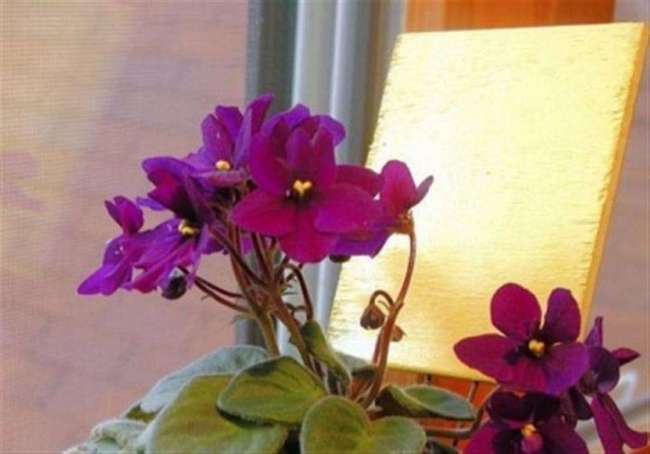

Follow-up care and re-flowering
After such an abundant flowering, the violet bush rest is required to build new foliage... After all, the peduncle can appear from the leaf axil only once.
Therefore, the bush begins to prepare for the repeated abundant flowering only six months later, so as not to completely exhaust the Saintpaulia bush. During rest, top dressing is used with a predominant proportion of nitrogen particles. for building up green mass.
It is necessary to use fertilizing with nitrogen carefully so that the growth of the violet does not become too fast and does not turn the rosette into a huge bush to the detriment of the formation of flower shoots.
Simple answer
Indeed, nothing could be easier. If you are looking for a way to make a violet bloom, then you have made mistakes in its content. This plant is not too whimsical, but there are a number of features that you need to know. Otherwise, a green bush will constantly sit on your window without a hint of buds.
What mistakes can a florist make? As a rule, this applies not only to light or temperature conditions.The wrong choice of soil, fertilizers and other care elements - all this together leads to the fact that the long-awaited flowering is postponed. What should a novice florist do? How to make a violet bloom? It is logical to assume that it is necessary to change the growing conditions - and the effect will not be long in coming.
